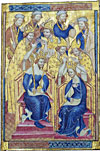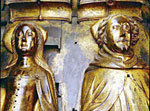sources » Anne of Bohemia
Anne of Bohemia

Liber Regalis. The coronation of a king and queen (London, Westminster Abbey, MS 38, f. 20). The Liber Regalis is a 14th-century coronation manuscript.
Larger image (96KB)
On 20 January 1382 Richard II married Anne of Bohemia (1366-94), daughter of the Emperor Charles IV and sister of Wenceslas IV of Bohemia, 'this tiny scrap of humanity', as the Westminster chronicler described her. Two days later she was crowned. One of the royal crowns had been recovered from pawn in London for her coronation. Contemporaries criticised the marriage on two grounds: Anne had no dowry, and she was escorted by a large and expensive suite of Bohemian ladies and gentlemen, to some of whom Richard granted annuities.
Although the union was childless, this seems to have been a marriage of true affection. Anne nearly always accompanied Richard as he travelled about England. Little is known of her character, but she fulfilled the traditional role of a queen in acting as intercessor for those who had incurred the king's anger. Richard was deeply grieved at her death in 1394. He ordered the manor at Sheen where she had died to be torn down. Anne was buried in the Confessor's chapel behind the high altar in Westminster Abbey.
The double tomb

Anne of Bohemia and Richard II. Detail from the double tomb (London, Westminster Abbey)
In 1395 Richard sealed contracts for a monument for himself and for Anne. This was an innovation, the first time a double tomb was ordered for an English royal burial. Contracts for the base of Purbeck marble were sealed with two London masons, Henry Yevele and Stephen Lote, and for the two life size effigies with Nicholas Broker and Godfrey Prest, both coppersmiths of London. Designs, now lost, were supplied to both sets of craftsmen. The coppersmiths' contract stipulated that the effigies were to be made of gilded copper and latten and to lie under canopies. They were to be crowned, their right hands were to be joined, and they were to hold sceptres in their left hands.
Although the crowns and other attributes are lost, as are the small images of saints and angels, the beautiful decoration on the effigies depicting the badges of the king and queen in pointillépointillé - pattern formed of dots incised with a fine point still survives. After his deposition and murder in 1400, Richard was buried at Langley in Buckinghamshire. His body was moved to lie beside Anne only on Henry V's accession in 1413.
Jewels and plate of Anne of Bohemia
We do not know what valuables Anne brought with her from Bohemia, but five jewelled collars with one or both of her badges of the fern and the ostrich are described in the treasure roll.

Ostrich badge in pointillé. Detail from the double tomb (London, Westminster Abbey).
Larger image (38KB)
R 63 Item, un coler de la livere la roigne que dieu assoille, garnis' ove rubis en hostrich', xvij gross' perlez , xxxv autres plus petitz perlez, pois' vij unc', et vaut outre vj li., donnt la somme, Cxiij li. xviijs. iiijd.
[Item, a collar of the livery of the late queen, may God have mercy on her soul, set with rubies in an ostrich, seventeen great pearls, thirty-five other smaller pearls, weighing 7 oz., additional value £6, total value, £113 18s. 4d.]
R 80 Item, un coler d'or de la ferne de la livere la roigne ove un ostrich enaymelle blanc et j diamant, pois' xj unc', summa, xxxiiij li. xiijs. iiijd.
[Item, a gold collar of the fern of the livery of the queen with an ostrich enamelled white and a diamond, weighing 11 oz., total, £34 13s. 4d.]
Also listed in the roll are basins, bottles and spiceplates, all large, all in pairs and of silver-gilt, marked with the impaled armsimpaled arms - two coats of arms set side by side on a shield of 'the Emperor' (presumably Anne's arms, derived from her father, Charles IV, 1316-78), and of 'the king'. Some of these could perhaps have come from Anne's trousseau, but at least one pair of basins marked in this way seems to postdate her arrival in England and to have been a gift. It had a livery collar of John of Gaunt, duke of Lancaster, Richard's uncle, around the arms. Among the chapel goods a paxpax - tablet of precious metal, ivory, etc., decorated with a sacred image, for transferring the kiss of peace at the mass from the celebrant to the clergy and laity is described as having Anne's arms and those of Richard II.
